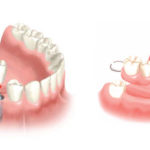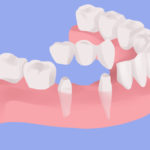A bridge is exactly as it sounds. The teeth on either side of the space are crowned and a fake tooth is hung between them, just like a bridge across a river. Unlike a bridge in nature though, there is not a large space under the fake tooth and food debris does get stuck. It is required to clean under the fake tooth with a special floss threader to keep plaque and food free from the area. If it is not kept clean, then decay will occur on the neighboring crowned teeth and the bridge will have to be replaced.
We have many patients that assume if the tooth is crowned, it cannot get a cavity again but that is not true.
The number one location that patients miss removing plaque is along the gum line and this is where the crown margin lies. This margin is a natural gap (albeit very small if done correctly) that harbors bacteria naturally and is very susceptible to decay. Leaving plaque in this area is detrimental to the long-term success of bridges as a restoration. If oral hygiene is impeccable, bridges can last 20 or more years. On average though, they last 7-10 years before needing to be replaced.
A bridge also requires crowning the neighboring teeth. In cases where this treatment is recommended, it is because the neighboring teeth would benefit from a crown. These indications would be teeth with large fillings, fracture lines, or an existing crown that needs replacement. In the process of preparing the neighboring teeth for crowns, they are more susceptible to nerve damage and possible root canals in the future. This is the case any time we have to drill on a tooth – always something to keep in mind.








